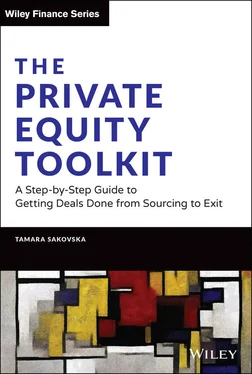1 ...8 9 10 12 13 14 ...17 I was advised by my senior colleagues early in my career to approach industry and deal networking with caution and develop relationships as a two-way street. Even though I might be dealing with senior industry executives who know a lot more about the sector than I, I may still be able to provide them with something valuable—such as an important introduction, access to my network or our firm's take on the industry, provided that our insights are non-confidential. Sharing articles, exchanging views, organizing industry dinners or thematic away days at my firm have proven to be productive ways to keep in touch and ensure that my network remained active.
However, my colleagues maintained that I stay cautious throughout all of this. Why? Because it is important that my intentions remained completely transparent to the people assisting our fund. I needed to discern genuine goodwill from an expectation of immediate or future fees, especially those that had not been agreed upon or earned. In my personal experience (and in that of my peers), the only way to avoid a misunderstanding of this nature was to have an upfront conversation about how our fund worked with outside parties and enter into any written agreements fairly early in the project.
Finally, it is important to recognize that apart from getting truly valuable insights, your new network might provide you with information that is biased, speculative or outdated. Some industry participants may offer a perspective that is too narrow and rigid, driven by their subjective experience in the sector. Others may be so focused on their own visibility in the industry, talking to the press and other matters of personal prestige that they might lose sight of the fact that their sector views have long since become stale. For this reason, I recommend that you establish the credibility of your new contacts early on and verify some of their views with a couple of alternative sources of information. This is a good way to ensure that people entering your network are knowledgeable, thoughtful and can serve as trustworthy sources in your quest to develop proprietary insights into an industry.
5. Establish a long list of potential deal targets and initiate coverage of these companies

The real action starts now! It is time to revisit the market map of the key players in the industry you created in step three. What companies on this list could be viable deal targets? Are you aware of any deal catalysts that could facilitate a private equity transaction? As I mentioned before, some companies will be on your list for benchmarking purposes only because they may be too large, publicly listed or already subject to recent private equity activity. Your objective at this stage is to review the market map thoughtfully and create a list of possible deal targets, some of which might consider a private equity investment in fairly short order and some of which will need to be converted into transactions over a period of time. It is a great idea to keep this inventory of deal ideas confidential and not mention any of the companies to anyone outside your firm in order to avoid leaking your proprietary ideas to the competition.
Now is a good time to become more familiar with the companies on your list. The only problem is that they don't yet know that you are looking at them, so you will have to initiate an in-depth coverage of these companies from your desk. Set up alerts that capture valuable information, such as financial reporting, regulatory filings, public statements, press releases, interviews and comments in business and trade journals. Analyze the presence of these companies on the internet and on social media platforms, especially if they operate in a consumer-facing sector. There are data analytics tools that can help you monitor and systematize vast amounts of data, such as the number of posts, quality ratings and customer reviews. If you need help in this domain, there are specialized firms who can provide social media monitoring and who will alert you of any meaningful spikes in traffic.
What are you looking for exactly? You need to stay abreast of any latest corporate developments and watch out for what Teten and Farmer (2010) aptly define as “deal signals.” These are trigger events that might make the company more receptive to accepting an investment from a private equity firm. They include any signs of instability affecting the corporation in the following areas:
Shareholders: parent company in distress, fighting off a takeover approach, private equity owner seeking an exit, large enterprises selling non-core divisions and any subsequent events following “death, disease, divorce,” especially in family-owned businesses.
Leadership: changes in strategic direction, succession battles, resignations and new appointments in the top management team or at board level.
Company performance: rapid growth that cannot be sustained with internal cash generation, production bottlenecks, large capital expenditure needs, persistent underperformance, excessive leverage or limited access to debt sources, or inability to exploit growth opportunities without additional capital.
Industry developments and pronounced structural shifts: industry consolidation or disruption, increasing rivalry among key competitors, new sources of pressure from customers or suppliers and any significant macro shifts creating the pockets of “economic turbulence” discussed earlier.
6. Rank the companies by attractiveness and approach two or three potential deal targets at a time

The time has come to start reaching out to the most promising prospects. By now you have hopefully spent enough time on desktop research of the companies on your deal target list and learned many noteworthy up-to-date facts about them. What's the best way to begin outreach? First of all, you will need to rank all companies in your deal inventory list: your top targets will be those businesses that feature the most obvious deal catalysts and represent the best fit with your investment thesis. Next, you will need to choose two or three top targets for your initial outreach. Why so few? Because reaching out to companies in a thoughtful and professional manner is time-consuming: you will need to craft a compelling initial message for each target and ensure that you follow up in an organized way. My advice is to start slow and add more deal targets only when you have fully exhausted the first few so that you are working on no more than two or three leads at any given time.
How do you contact companies? If there is no obvious way in through your firm's existing network and no possibility of a warm introduction by one of the industry experts you know, then the only way to make contact is through a cold call. Most private equity professionals feel nervous even thinking about cold calling, let alone going through with it. Unless you did door-to-door sales during your school years, you might have the same reaction to cold calling too. After all, most of us have developed a stigma toward irritating spammers and telemarketers, and none of us are in any rush to join their ranks. As humans, we also suffer from fear of rejection: when you make your first contact with managers of a company you know only through desktop research, there is a considerable chance that they will decline your request for a meeting. If they are inundated with cold calls, they might even make you feel bad about yourself for trying to solicit their attention. What then? It is good to remember that cold calling is an effective, time-tested strategy and that some private equity firms really excel at it. There are a few funds, such as TA Associates and Summit Partners, who manage to differentiate themselves in the crowded private equity middle market by pursuing prolific cold calling programs that involve making unsolicited calls to literally thousands of companies every year. 5
Читать дальше














